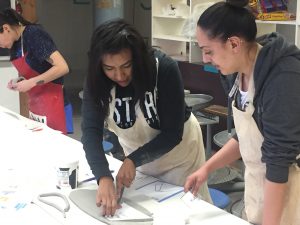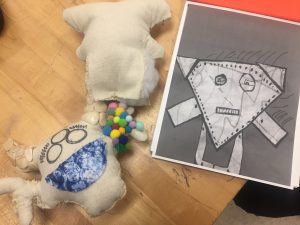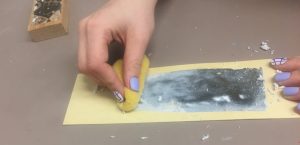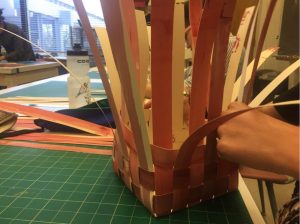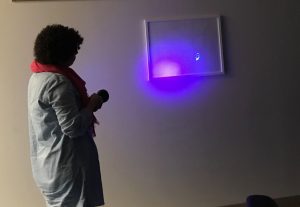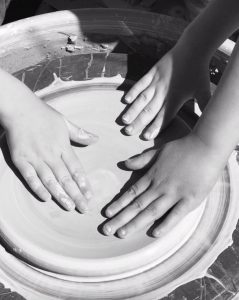Justin Makemson PhD is an assistant professor of art education in UNM’s Department of Art Studio-History-Education and President-Elect of the New Mexico Art Education Association. Makemson has worked in teacher preparation in art education for over ten years...
ART EDUCATION
Everywhere. Everyone. Art Education.
The University of New Mexico is committed to diversity, equity, inclusion, and belonging in visual art education.
UNM Art Education coursework and teaching practicums help prepare students to work with different populations and to work in a variety of settings through exposure to and situated practice in differentiated instruction and culturally-relevant, culturally-responsive, and culturally-reciprocal pedagogies.
Here community, cultural backgrounds, and the lived experiences of students work to shape the direction of visual art education and open pathways often overlooked in more traditional learning designs.
UNM Art Education offers five programs of studies in visual art education, with three options that prepare students with the coursework and teaching practicum experiences required to apply for New Mexico Visual Arts PreK-12 Licensure:
- Bachelor of Arts (B.A. in Art Education) with Licensure
- Bachelor of Arts (B.A. in Art Education) without Licensure
- Post-Baccalaureate in Art Education with Licensure
- Master of Arts (M.A. in Art Education) with Licensure
- Master of Arts (M.A. in Art Education) without Licensure
The licensure and non-licensure options support students with a wide range of interests.
Undergraduate ARTE Options
For undergraduate students, the licensure option prepares students to teach visual art in public schools (which requires a current state-issued teaching license), private schools, charter schools, museums, parks, and/or community-based organizations. The University of New Mexico is the only educator preparation program for visual art education in New Mexico recognized by the New Mexico Public Education Department (NMPED). All students in licensure-track options are required to pass state-sanctioned licensure examinations before being eligible to apply for a teaching license.
By comparison, the undergraduate non-licensure option (open to students starting the program in 2022) prepares students to work in art education as educational coordinators, designers, organizers, instructors, facilitators, curators, docents, guides, counselors, support staff, and/or service providers. The non-licensure option combines preparation in art education with preparation in a second area of concentration supporting the student’s professional goals and intentions.
Post-Baccalaureate ARTE Option
The Post-Baccalaureate in Art Education designed for students with a degree in studio art, design, art history, or a related visual arts concentration to complete the coursework and teaching practicum experiences required to apply for New Mexico Visual Arts PreK-12 Licensure. Per state licensure requirements, the student’s existing degree needs to include a minimum total of twenty-four hours in the visual art content area (studio art and/or art history) with twelve or more hours in the content area completed at the 300-level or higher.
Post-Baccalaureate
Art Education
Graduate ARTE Options
For graduate students, the licensure option prepares students to work in similar roles and situations as the undergraduate licensure option. The graduate options do however promote a deeper-level understanding of art education including theoretical foundations, contemporary art pedagogies, art teacher-researcher reflective practices, community connections, and emerging questions and contemporary issues related to the field.
The M.A. in Art Education can be used to prepare graduates to research, serve, and advocate within the field of art education, and/or can be used as a prerequisite in continuing on to a doctorate degree in art education or a related concentration. Practicing licensed teachers can also use the non-licensure graduate program to advance to a higher level within the New Mexico Public Education Department’s (NMPED) licensure system.
UNM Art Education graduate students are required to complete a capstone research project prior to graduation; students have the option to complete a thesis project, an action research project, a curriculum project, or an exhibition project. Each capstone research project option concentrates more or less on a different category of scholarship (e.g. the action research and thesis options concentrate more on discovery and integration, while the curriculum and exhibition projects concentrate more on engagement and teaching and learning), however, the four options all work within a relatively similar proposal-preparation-development-defense structure and schedule of completion.
Graduate-Level Minor in Art Education
FACILITIES
Historic Masley Hall is a learning space shared between Art Education, Pueblo Pottery, and the New Mexico Musical Heritage Project and located in the heart of UNM’s central campus. The building includes elementary and secondary methods classrooms, ceramics studio, printmaking studio, fabrication lab, photography suite, conference and seminar rooms, and the Masley Gallery of Art.
Art Education Gallery
STUDENT ORGANIZATIONS
Art Education Graduate Student Association
UNM’s Art Education Graduate Student Association (AEGSA) is a registered student organization that has been active within the Art Education Program since 2000. AEGSA represents, supports, and advocates for the UNM Art Education Program and its students. The AEGSA group undergraduate student leadership regularly partners with the region’s extended community of teachers, schools, museums, community organizations, and others.
National Art Education Association Student Chapter
UNM’s Student Chapter of the National Art Education Association is the university-level affiliate of the National Art Education Association (NAEA) and the New Mexico Art Education Association (NMAEA). The student chapter under undergraduate student leadership concentrates on community building and connecting UNM art education students to professional resources and networks at the local, regional, and national level. The student chapter also coordinates with the AEGSA group to sponsor monthly events including speakers, site visits, gallery crawls, and creative workshops.
FACULTY
Gigi Schroeder Yu
Assistant Professor
Gigi Schroeder Yu, PhD is an assistant professor in art education in the art department at the University of New Mexico. She has also previously taught at Millikin University and DePaul University. Yu has over 20 years of experience teaching art...
Jeff Horwat
Assistant Professor
Dr. Jeff Horwat is an artist, teacher, and researcher from Emmaus, Pennsylvania. Jeff earned his Bachelor of Science in Art Education at Kutztown University of Pennsylvania, and later received a Master of Science in Art Education at Massachusetts College of Art & Design and a Doctorate in Art Education at the University of Illinois at Urbana-Champaign.

Dr. Alexander Simeon Masley (1903-1996) founded the University of New Mexico’s visual art education program (then in the Department of Art Education) in 1947. Born in 1903 in Akeley, Minnesota, Masley attended the University of Minnesota and the Minneapolis School of Art. He received a doctorate from Columbia University’s Teachers College. Masley served as the first chairperson of the department from 1950 to 1968, before retiring as Professor Emeritus in 1969.
The Smithsonian American Art Museum holds five of Masley’s engravings in its collection; the Minnesota Historical Society has 21 of his artworks in its collection. Images of Dr. Masley’s work can be seen here, here, and here.
or
UNM Art Education has determined that its curriculum meets the state educational requirements for licensure or certification in New Mexico. UNM Art Education has not made the determination that its curriculum meets the state education requirements for licensure or certification in all other states, and students interesting in exploring reciprocity in teaching licensure in another state need to contact the licensing organization for that state.


